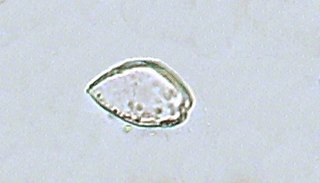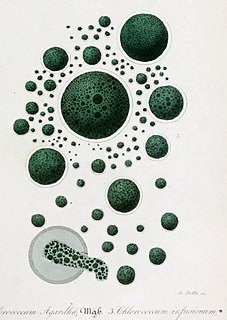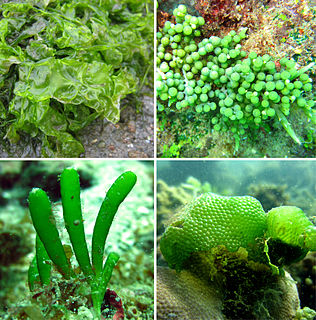
The Prorocentrales are a small order of dinoflagellates. They are distinguished by having their two flagella inserted apically, rather than ventrally as in other groups. One flagellum extends forward and the other circles its base, and there are no flagellar grooves. This arrangement is called desmokont, in contrast to the dinokont arrangement found in other groups. Accordingly, the Prorocentrales may be called desmoflagellates, and in some classifications were treated as a separate class Desmophyceae.

The cryptophyceae are a class of algae, most of which have plastids. About 220 species are known, and they are common in freshwater, and also occur in marine and brackish habitats. Each cell is around 10–50 μm in size and flattened in shape, with an anterior groove or pocket. At the edge of the pocket there are typically two slightly unequal flagella.
In molecular biology, a twintron is an intron-within-intron excised by sequential splicing reactions. A twintron is presumably formed by the insertion of a mobile intron into an existing intron.

The Trebouxiophyceae are a class of green algae, in the division Chlorophyta. Their circumscription within the green algae is not well established due to the need for more genetic studies at higher levels within the group.

Chlorococcum is a genus of green algae, in the family Chlorococcaceae. The alga may be useful in the flocculation of lipids from wastewater.
Trichosarcina is a genus of green algae in the order Ulotrichales. Filoprotococcus was once regarded as a synonym. However, Filoprotococcus is now considered valid in its own right. Trichosarcina is considered to be of uncertain validity.
Rhexinema is a genus of green algae in the order Ulotrichales. Recent research has suggested that the genus Helicodictyon is a synonym of Rhexinema.
The Mesostigmatophyceae are a class of basal green algae found in freshwater originally containing two species in a single genus, Mesostigma. Now, a clade containing Chlorokybus and Spirotaenia has been added. The Mesostigmatophyceae are either placed as sister to all other green algae, or more conventionally as sister to all Streptophyta.
Filoprotococcus is a genus of green algae in the order Ulotrichales. It was once regarded as a synonym of Trichosarcina. However, it is now accepted as a genus in its own right, and Trichosarcina is considered taxonomically uncertain.
Telonema is a genus of single-celled organisms.

Erythrotrichia is a red algae genus in the family Erythrotrichiaceae. In Iceland, E. carnea is red listed as a vulnerable species (VU).

The Chlorophytina are a proposed basal Tetraphytina clade. It is currently seen as sister of the Pedinomonadaceae. It contains the more well-known green alga and is characterized by the presence of phycoplasts.

Pyrenomonadaceae is a family of cryptomonads which includes three or four known genera. They are distinguished from other cryptomonads by their nucleomorphs being imbedded into the pyrenoid, and the presence of distinctive pigment phycoerythrin 545.





